16.11.21
Aber Falls Visit; anCnoc and Cotswolds on Taste; Oldest Ever Singleton
Last week, I found myself in three different countries of the UK in one day. Needed only Northern Ireland for the full set. Not to be, however. In this week‘s column I‘m talking about my visit to Aber Falls Distillery in North Wales and tasting new expressions from anCnoc (Knockdhu Distillery) on Speyside and Cotswolds Distillery in England. Info arrived a couple of days ago on a new Singleton from Diageo. Just yesterday came news that Heineken has bought Distell, based in South Africa. At the moment I don‘t know if this affects ownership of the whisky side of the business which includes Bunnahabhain, Deanston and Tobermory in Scotland. Hoping to ask some questions soon.
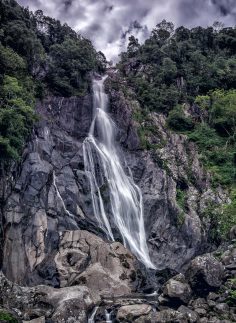 I‘ve featured tasting notes before on a couple of Aber Falls expressions and they kindly invited me down to have a look at the place and provided suggestions for other visits. The trip was made easier by a stop in Manchester over the weekend for a Tim Minchin gig (terrific). From my bit of Scotland to Aber Falls is nearly 5 hours without stops and the journey home (with a stop) in horrible rain seemed pretty long but it‘s easy to make stops en route and doesn‘t have to be a long slog. The only major drawback was my car satnav deciding to take us down some of the tiniest roads known to man in Wales (I reckon the human birth canal might be wider) to get to our hotel from the distillery that afternoon (8th November).
I‘ve featured tasting notes before on a couple of Aber Falls expressions and they kindly invited me down to have a look at the place and provided suggestions for other visits. The trip was made easier by a stop in Manchester over the weekend for a Tim Minchin gig (terrific). From my bit of Scotland to Aber Falls is nearly 5 hours without stops and the journey home (with a stop) in horrible rain seemed pretty long but it‘s easy to make stops en route and doesn‘t have to be a long slog. The only major drawback was my car satnav deciding to take us down some of the tiniest roads known to man in Wales (I reckon the human birth canal might be wider) to get to our hotel from the distillery that afternoon (8th November).
Anyway, to the distillery. It‘s situated off the main road that runs along the North Wales coast and sits between the Menai Straits and Snowdonia National Park. You pass near/through a number of well-known seaside holiday towns and not far from the university town of Bangor.
Size-wise, it‘s small – annual production 200,000 l.o.a. – and perfectly formed with a super and quite young 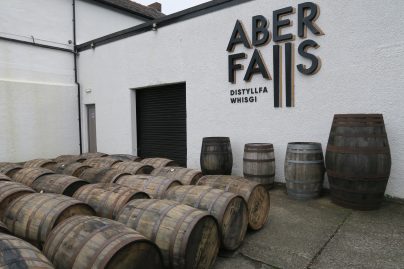 team running things on both the distilling and visitor sides. The Master blender is Dr. Kirstie McCallum, ex of Distell and La Martiniquaise, though she covers many of the parent company sites and wasn‘t there on the two days of my visit. The distillery was founded in 2017 so the whisky has fairly recently reached maturation (by Scotch rules) and is part of the Halewood Group which owns spirits and other brands in a number of countries. The visitor centre was opened only this year. Well, we‘ve had other problems since February 2020, haven‘t we? Speaking of Scotch rules, the Managing Director, James Wright, pointed out that they‘re working with other distillers in Wales (there are 5 in total at present) to set up a Protected Geographical Origin designation for Welsh Whisky and to create in law,
team running things on both the distilling and visitor sides. The Master blender is Dr. Kirstie McCallum, ex of Distell and La Martiniquaise, though she covers many of the parent company sites and wasn‘t there on the two days of my visit. The distillery was founded in 2017 so the whisky has fairly recently reached maturation (by Scotch rules) and is part of the Halewood Group which owns spirits and other brands in a number of countries. The visitor centre was opened only this year. Well, we‘ve had other problems since February 2020, haven‘t we? Speaking of Scotch rules, the Managing Director, James Wright, pointed out that they‘re working with other distillers in Wales (there are 5 in total at present) to set up a Protected Geographical Origin designation for Welsh Whisky and to create in law, 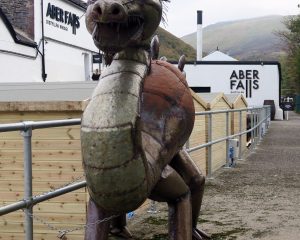 for Wales, production rules/standards that govern production. At the moment they are freer to try things that we in Scotland aren‘t allowed or encouraged to do e.g. they don‘t have to use oak casks, though in practice they do. A separate part of their production is gin and there‘s a super gin lab (opened in October) in the visitor centre where you can create your own gin and bottle it to take home. Outside the distillery is a dragon but it‘s Chinese rather than Welsh and they grabbed the chance to acquire it despite its non-Welsh ethnicity. I don‘t know if there are plans to „welshify“ its appearance!
for Wales, production rules/standards that govern production. At the moment they are freer to try things that we in Scotland aren‘t allowed or encouraged to do e.g. they don‘t have to use oak casks, though in practice they do. A separate part of their production is gin and there‘s a super gin lab (opened in October) in the visitor centre where you can create your own gin and bottle it to take home. Outside the distillery is a dragon but it‘s Chinese rather than Welsh and they grabbed the chance to acquire it despite its non-Welsh ethnicity. I don‘t know if there are plans to „welshify“ its appearance!
I‘ve shown a picture of their water source waterfall before – it‘s 120 feet high and very impressive. One of the suggestions made was a walk to the top of the waterfall on Tuesday afternoon but the weather was pretty poor. One for another day as it would be spectacular in better weather. The site of the distillery was once a slate works (Wales is famous for its slate for roofing) and then a margarine factory between the two world wars. It has its own microclimate and, in terms of sustainability, they are looking at hydro-electric power if the equipment can be put in place to allow them to power the place that way. There‘s a local hydro capability for the village and any money the distillery would pay for its power would go back into the village community.
Distillation is largely as you‘d find in Scotland though they have two condenser columns coming from the stills – one copper and one stainless steel 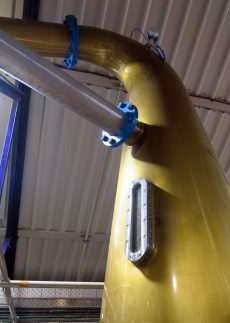 so they can vary the character of the spirit. That will give a lot of creative flexibility in future. Glen Edwards who showed us round advised the spirit from the copper column is biscuity and lighter while that from the steel is more leathery and meaty. I tried both later and the difference is very marked.Their aim is to take 60% of their spirit from the steel and 40% from the copper. Most of the casks they use at present are ex-bourbon (60 – 70%) with about 20% being sherry and the rest is virgin oak. Some 36 casks are filled each week and there are about 4,500 casks in warehousing in Bangor where the bottling is being relocated. The only new whisky I tried there was their current Distillery Exclusive 2021 matured in an orange wine cask. I‘ll hold back the tasting notes for now but it was certainly an enjoyable expression.
so they can vary the character of the spirit. That will give a lot of creative flexibility in future. Glen Edwards who showed us round advised the spirit from the copper column is biscuity and lighter while that from the steel is more leathery and meaty. I tried both later and the difference is very marked.Their aim is to take 60% of their spirit from the steel and 40% from the copper. Most of the casks they use at present are ex-bourbon (60 – 70%) with about 20% being sherry and the rest is virgin oak. Some 36 casks are filled each week and there are about 4,500 casks in warehousing in Bangor where the bottling is being relocated. The only new whisky I tried there was their current Distillery Exclusive 2021 matured in an orange wine cask. I‘ll hold back the tasting notes for now but it was certainly an enjoyable expression.
When I was there wooden stalls were being constructed to house an upcoming Christmas market and the distillery also supports a local farmers‘ market. That‘s one interesting aspect I found different from Scotland. They are actively working with other local food and drink producers to promote one another‘s goods and services and „visitability“ as a community. It may be because we have much more distillery concentration in Scotland but I‘m not aware of any similar efforts here. Yes, distilleries sell things from other local businesses in their shops but there isn‘t the same collective promotional effort.
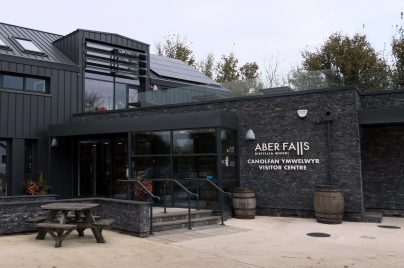 The distillery has become something of an area hub because of its bistro, hence the location for a Christmas market. The bistro is excellent with their gin infused fruit scones with orange marmalade cream my new favourite thing. From a tourism point of view, we enjoyed dinner at Dylan‘s on the Menai Strait but sadly, at his time of year, it was too dark to see much of the great view we were told there is from the restaurant. Good food and lovely staff though. Similarly at our hotel, the Hilton Garden Inn in Snowdonia National Park. Great staff who printed us directions to get to Dylan‘s as there were some local road closures for repairs and to prevent my satnav from getting us lost again. Didn‘t stop us from getting slightly lost on the way back, though. We drove round Conwy Castle several times but the lovely owner of the local kebab shop set us back on track. By the way, for all you whisky fans who like to surf, that hotel is right beside a surfing centre with its own lagoon. Speaking of castles too, there are several impressive ones to see in the area and the village of Portmeirion isn‘t too far away. For those with a liking for 1960‘s TV series, it was the setting for The Prisoner and has really interesting architecture. I didn‘t make it there this time but hope to get back. I hadn’t visited a distillery in Wales before but would recommend this one. Maybe a tour of UK distilleries? Now that would make a great holiday.
The distillery has become something of an area hub because of its bistro, hence the location for a Christmas market. The bistro is excellent with their gin infused fruit scones with orange marmalade cream my new favourite thing. From a tourism point of view, we enjoyed dinner at Dylan‘s on the Menai Strait but sadly, at his time of year, it was too dark to see much of the great view we were told there is from the restaurant. Good food and lovely staff though. Similarly at our hotel, the Hilton Garden Inn in Snowdonia National Park. Great staff who printed us directions to get to Dylan‘s as there were some local road closures for repairs and to prevent my satnav from getting us lost again. Didn‘t stop us from getting slightly lost on the way back, though. We drove round Conwy Castle several times but the lovely owner of the local kebab shop set us back on track. By the way, for all you whisky fans who like to surf, that hotel is right beside a surfing centre with its own lagoon. Speaking of castles too, there are several impressive ones to see in the area and the village of Portmeirion isn‘t too far away. For those with a liking for 1960‘s TV series, it was the setting for The Prisoner and has really interesting architecture. I didn‘t make it there this time but hope to get back. I hadn’t visited a distillery in Wales before but would recommend this one. Maybe a tour of UK distilleries? Now that would make a great holiday. 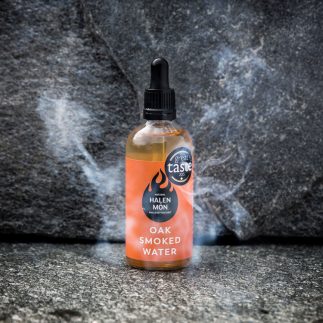
The other visit suggested by Aber Falls on this trip was to Halen Mon who produce Anglesey sea salt, much in demand by good restaurants and keen cooks and not just in the UK. As well as a display on the history of salt you can see the crystals being harvested and do a salt tasting. I am here to tell you that salt isn‘t just salt. There‘s the fine stuff you buy in the supermarket and you try two types of their crystals as well as smoked and flavoured salts. The taste differences are fascinating. There‘s a tiny sample to take away but the shop is full of that and other items. I had to come away with some of their salt crystals, a jar of salted caramel and – a delightful find – oak smoked water. What?! Yes, they run water through smoked oak chips in a separate building for use in cooking and flavouring. One of the things I intend to do is experiment with it to add a drop or two to whiskies to see the effect. They suggest using a little in ice cubes to add into whiskies and cocktails too. I‘m told a little goes a long way. Haven‘t had time to try it yet so I‘ll probably report back on that next time.
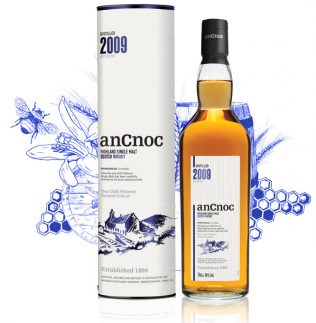 I‘m coming back to Scotland now to talk about anCnoc 2009 Highland Single Malt (46% vol/NAC/NCF), the latest release from Inver House‘s Knockdhu distillery. The whisky was matured in first-fill Spanish sherry butts and ex-bourbon barrels.
I‘m coming back to Scotland now to talk about anCnoc 2009 Highland Single Malt (46% vol/NAC/NCF), the latest release from Inver House‘s Knockdhu distillery. The whisky was matured in first-fill Spanish sherry butts and ex-bourbon barrels.
Appearance: Medium barley gold. Brass and old gold highlights. Tears quite clingy and not too close or too wide.
Nose: Initially a very „dry“ nose and meaty (umami) a bit like beef stock and a touch of onion powder. Then there‘s also vanilla, spices and sweet oak like you inhale in an earthen floored warehouse. More sweet notes develop as it sits in the glass – fruit, sugar syrup and more oak vanilla. Also honey and a tiny bit of citrus zest. With water the sweetness is more to the fore – icing sugar over plum and vanilla cake. Light fruit – maybe quince. The sweetness continues with honey and some burnt sugar candyfloss notes.
Palate: Medium mouth weight. Slight astringency. Malted barley and umami, mushroom-like notes at first. A dab of sulphur from the sherry wood, spices and oak. Some dried fruits – apricot – and slight bitter chocolate and citrus zest. Barley sugar. I don‘t get the butterscotch they mention – more a slightly bitter caramel.
Finish: Quite long with oak, malted barley sweetness and light dried fruits. It‘s not in your face – a rather delicate fade away from the palate.
It‘s characterful, complex but quite subtle at some points on the nose and taste journey. One to explore if you‘ve never tried anCnoc.
Last one for this time is the Cotswolds Distillery Bourbon Cask Single Malt (59.1% vol/NAC/NCF). You certainly wouldn‘t miss that this has 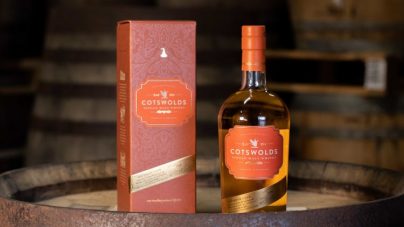 been in first-fill bourbon wood.
been in first-fill bourbon wood.
Appearance: Light straw gold with pale brass highlights. Tears slow to form nad clingy but close together.
Nose: Rich vanilla notes like ice cream or cake with vanilla buttercream. A bit of honey and lemon sugar syrup. Some oak, baked pears – sweet and enticing. There‘s a little bit of sweet toasted oak too, rather like a lightly oaked Chardonnay. Warm melted butter and vanilla tablet. With water there are more sugary buttercream or icing notes. A little more cask toast and a slight vegetal wisp. A very fresh nose.
Palate: Medium weight. A slight toasted oak bitterness. The overt sweetness on the nose is not repeated on the palate. There is some vanilla sponge cake and soft cake spices (despite being bourbon wood) but it‘s also dry on the tongue. Malty with some ripe pear and some dried cherry. They say raisin but I didn‘t get that.
Finish: Medium length and spritzy on the tongue with barley sweetness. It finishes dry with a lick of honey, toast and grasses.
I could have happily nosed this for ages. Young doesn‘t necessarily mean a poor dram and this isn‘t. As with one of their previous offerings I wrote about, I‘d like to follow progress of this exact version as it ages a bit just to see how it develops but it is worth looking at now. I‘d also like to see how it might be used in cocktails. Another expression from Cotswolds Distillery arrived the other day but no time or room for that here. We‘ll look at it next time.
Last news for now is that Diageo have released their oldest ever Singleton (Singleton of Glen Ord distillery) at 39 years old and it‘s been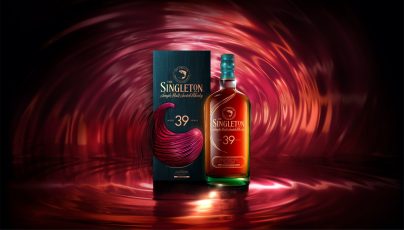 curated by Master Blender par excellence, Maureen Robinson. We‘re told, „With only 1,695 bottles available globally, this precious and luxurious vintage is The Singleton’s longest secondary maturation to date. Having aged in an inventive blend of casks, including those which had previously matured port, red wine, Pedro Ximénez & Oloroso, and then finished in French Bordeaux casks, the result of this dance between whisky and wined wood is rich and succulent.
curated by Master Blender par excellence, Maureen Robinson. We‘re told, „With only 1,695 bottles available globally, this precious and luxurious vintage is The Singleton’s longest secondary maturation to date. Having aged in an inventive blend of casks, including those which had previously matured port, red wine, Pedro Ximénez & Oloroso, and then finished in French Bordeaux casks, the result of this dance between whisky and wined wood is rich and succulent.
In the pursuit of creating the exceptional, Maureen Robinson has patiently guided and nurtured this whisky through its 27-year secondary maturation. Over a quarter of a century ago, Maureen Robinson took an elegant Singleton which had aged 12 years and rehoused it in hand selected European Oak casks which had previously held port wine, red wine and a blend of Pedro Ximénez and Oloroso wines. 27 years later, Maureen married these whiskies together in casks that previously held the most celebrated of European wines – Bordeaux. The Singleton 39-Year-Old will be available globally from selected retailers and Malts.com.“ Likely UK selling price is around £2,295 (duty and taxes incl.). In the US it will be around US$2,680 excluding duty and taxes. I’m sure it will be worth it but one for the Santa list, I think, unless you have deep pockets.
 I‘ll be back end of November with more tasting thoughts and any other matters that come to my attention plus, I hope, more on what the Distell sale might mean for the whisky end of things. Till then, happy dramming.
I‘ll be back end of November with more tasting thoughts and any other matters that come to my attention plus, I hope, more on what the Distell sale might mean for the whisky end of things. Till then, happy dramming.
Slainte,
Caroline
Comments